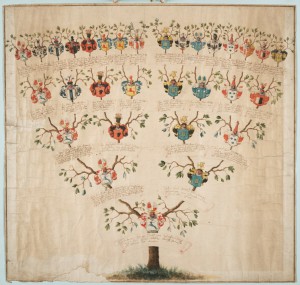The von Wolfframsdorff Armorial Family Tree
To poke one’s head inside the Conservation Lab here at NEHGS is to observe a beehive of activity. This is where our Conservation Technician Deborah Rossi, part-time interns, and volunteers repair and treat books and manuscripts from the NEHGS collections. Last year, they repaired and treated over 250 volumes, documents, and other works on paper. A wide range of items (and condition issues) make their way to the lab, and we’d like to share a recent example with you.
One item that is currently receiving treatment is an eighteenth-century hand-colored and handwritten armorial chart (pictured at left) of the ancestry of Royal Prussian Army captain Johann George Ernst von Wolfframsdorff, which hangs in an office here at NEHGS. This chart was acquired recently by the Society, and its story appeared in the Summer 2014 issue of American Ancestors.
When large color-illustrated items like pedigree charts, maps, and family trees come into the Conservation Lab for treatment, a digital photograph is taken before any other work is carried out. The next order of business is to review the condition of the piece. The von Wolfframsdorff chart appears to have been rolled at one point and suffered a great deal of mishandling before it arrived at NEHGS. There are many wrinkles throughout the piece, indicating that it may have been pressed down or bent when rolled up.
Many of the tears on the outside edge were mended with a one-inch strip of paper matching the paper of the chart and adhered to the back with mucilage glue. The strips will be removed and replaced with Japanese mending tissue known as kozo to improve the repair. The mending will be lighter in weight without compromising the strength of the repair, and it will be less noticeable. Missing pieces along the outside edge need to be infilled – a process of replacing paper where it has been lost.
The chart has also been exposed to elements in the air, mainly pollution, and to light, indicated by the yellowing of the background. All surface dust must be removed by first using a static brush. Some of the surface dirt may further be lifted with a Staedtler Mars plastic eraser.
In spite of the chart’s history of mishandling and the acidity in the paper, the colors of the gouache paint have remained remarkably vivid. Paint is always tested in the lab before any item receives water treatment, and in this case we can see that the green gouache would bleed, and therefore water treatment will be limited.
The wrinkles in the chart will be addressed by a two-part process. First, the piece will be placed in a humidifying chamber to relax the paper. When removed from the chamber, the paper is immediately sandwiched between two pieces of a smooth polyester called Hollytex – one on the top and one on the bottom, each followed by a piece of blotter. The Hollytex protects the paper from sticking to the blotter, and the blotter is there to absorb the moisture.
The von Wolfframsdorff chart will be put back into its original frame, but the housing materials will be traded out for acid-free ones, and a barrier will be created between the glass and the object. It will be returned to its place on the wall here at NEHGS, stronger and healthier thanks to the time it spent in our version of a hospital/spa for treasured books and manuscripts.
Share this:
About Jean Maguire
Jean Maguire was the Library Director at NEHGS until 2020, responsible for overseeing the Society’s library and special collections, including patron services; collection development, access, and preservation; and the Society’s volunteer program. Jean joined the NEHGS staff in 1999 after receiving her Master’s in Library and Information Science from Simmons College.View all posts by Jean Maguire →
